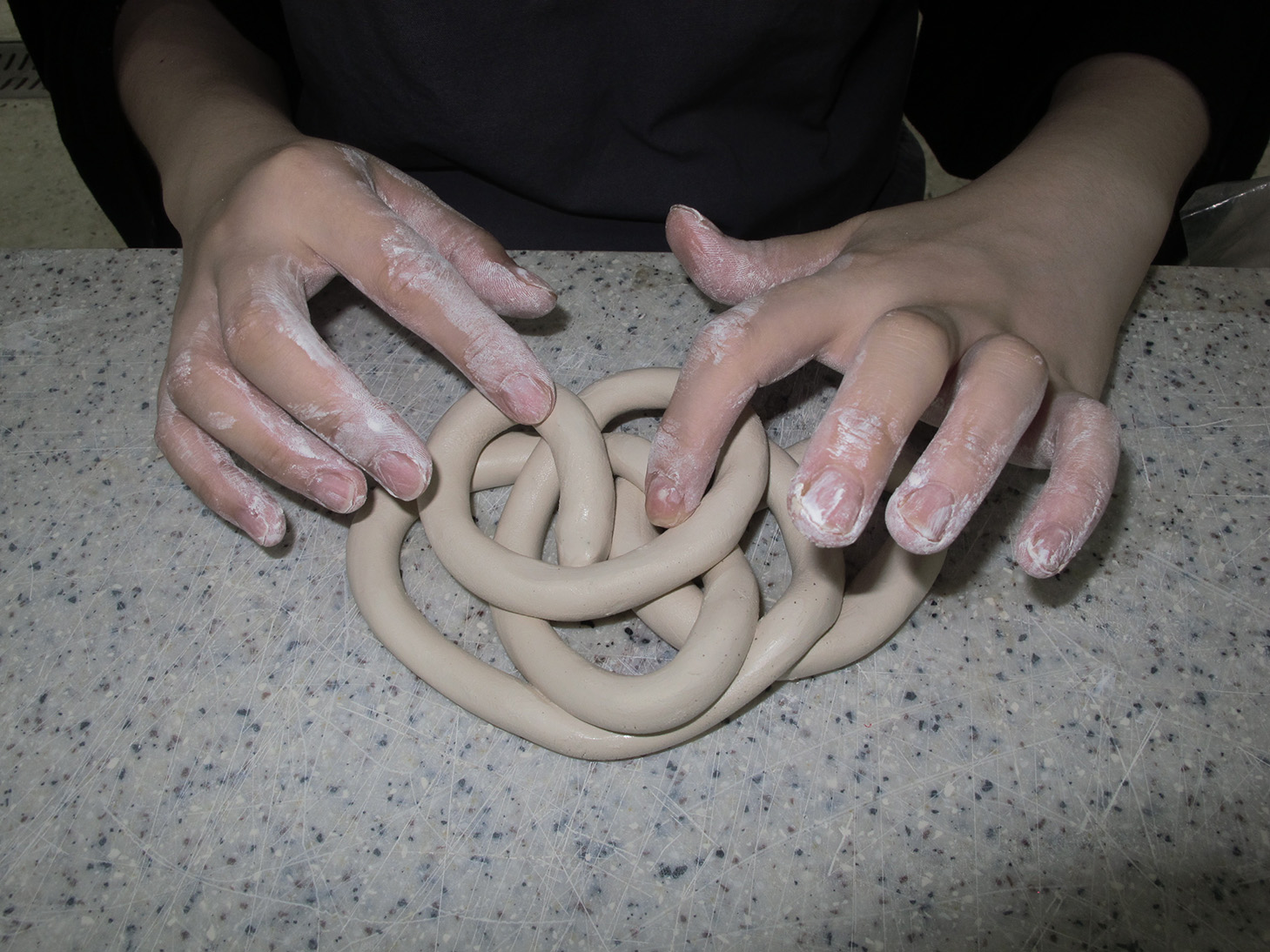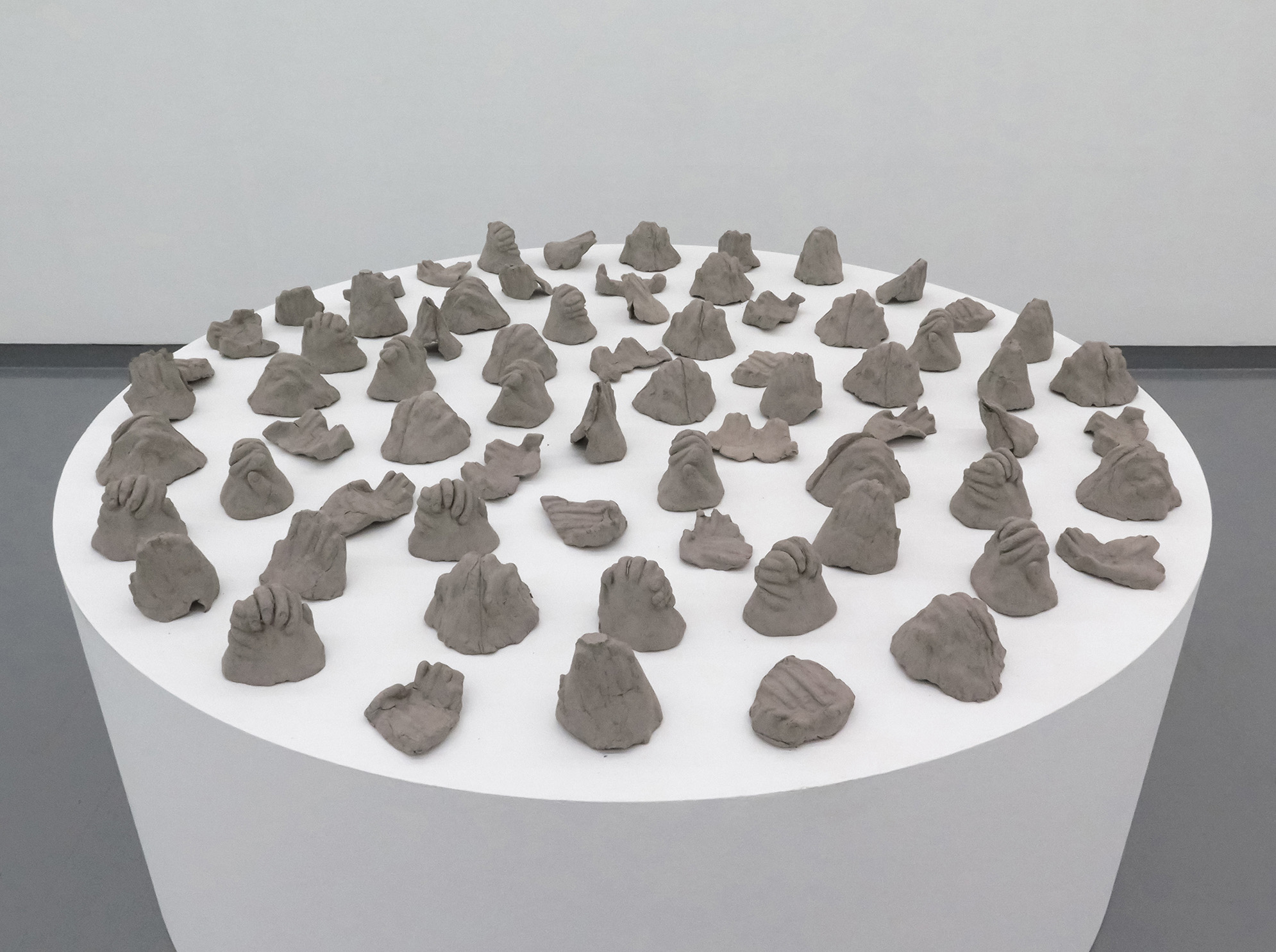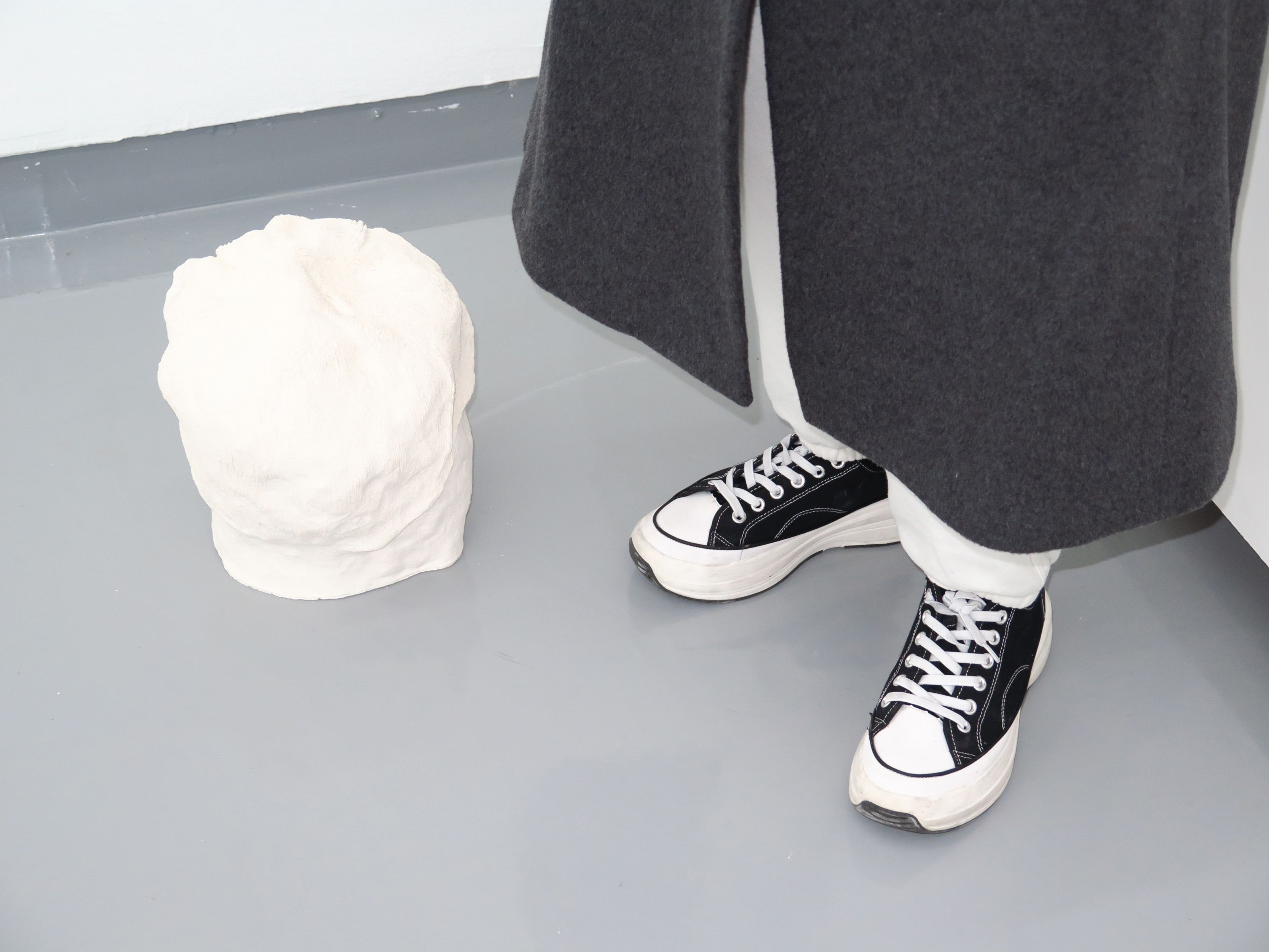바다와 산과 길이 있는 안녕
2022. 11. 25 – 2023. 3. 26
클레이아크김해미술관 큐빅하우스, 경상남도 김해
감각적연대
<물상>은 전시공간을 원경, 중경, 근경으로 나누고 작품을 산수풍경처럼 표현하려고 했다.
<사라지는 과정>은 <물상>의 첫 번째 레지던시, 세라믹창작센터의 입주기간 동안 지역을 유람하며 감각한 시간을 옮긴 작품이다. 경남 앞바다에서 촬영한 60장의 사진에는 변화하는 파도와 부표의 이미지가 담겨있다. 매초마다 촬영한 전체의 장면을 배경과 피사체로 분리하여 60장이 찍히는 동안 깃발이 바람과 파도에 의해 점차 사라지는 순서로 재배치하였다. 파도가 반복되고 부표의 깃은 납작해지다 끝내 사라지고, 전시되지 않은 61번째 장면을 짐작해볼 수 있다. 모든 것에는 시작과 끝이 있듯이 우리가 한시적으로 보냈던 시간과 경험을 작업으로 옮겨 의미를 되새기고자 하였다.
<사라지는 과정>이 바다의 인상을 그린다면 <비손>은 산의 기억을 재해석하는 작업이다. 기도하는 손의 형상 같기도, 계곡이나 골짜기를 끼고 있는 산 같기도 한 도자의 변주를 제작했다. 예부터 산이 가진 모서리는 신과 더 가까운 곳에서 만나려 했던 염원의 마음이 모인 곳이었다. 오를 수 있을 것 같지만 오를 수 없는 가깝고도 먼 믿음의 형상을 제작하기 위해 흙산을 쌓아올리면서, 산의 모서리에 맺힌 염원하는 마음과 물상에 동화되어 갔다.
기도가 마음을 압축한 양적인 속성을 가지는 반면 <비손_드로잉>에서는 연비(불교에서 손목에 향불을 놓는 의식)를 기법으로 이용하여 면을 덜어내는 동시에 그림이 드러나게 한다. 불이 종이를 관통하는 찰나의 순간을 이전과 이후를 경계 짓고 끊어냄으로써, ‘지워지면서 그리는’ 드로잉을 선택했다.
이러한 역설은 <유연한 드로잉>에서 표현의 미완결성과 주제의 대립으로도 드러난다. 흙과 흙이 아닌 것, 끈과 끈이 아닌 것들로 유사하지만 다른 재료를 모아 시각적으로 연결된 끈을 만들었다. 전시공간 안에서 하나의 긴 길처럼 두른 끈은 <물상>의 도자가 나아가야 할 길을 스스로에게 질문하는 시간으로, <물상>의 작품이 임시적이며 지나친 공간의 점유를 지양하는 작업관과, 무엇인가 완성 해내야 하는 창작의 속성 즉, ‘완성된 오브제’와의 갈등은 <물상>에게 풀어야 할 문제였음을 고백하는 과정이 되었다.
‘완성된 오브제’가 성형, 시유, 소성 등의 과정을 거친 작품의 완결성을 가리킨다면 도자에 숙련되지 않은 <물상>의 작업은 완성의 목표보다 도입부에 훨씬 더 성실해야 했다. 그것은 흙과 가까워지는 일이었고 흙이 가진 독특한 성질에 집중하는 일이었다. 말라서 쓸 수 없는 흙을 다시 물에 풀거나, 마르기를 기다리며 했던 관찰은 도자에 길을 내는 <도자기억법>으로 옮겨졌다.
<도자기억법>은 때때로 인물의 뚜렷한 생김새보다 온도, 냄새, 그림자 같은 어렴풋한 인상으로 기억되는 이미지를 생각한 작품이다. 돌아보면, 경험한 시간은 언제나 선택적으로 기억되며 본래의 상과 멀어지듯이 얼굴에 대한 기억도 불명확하게 뭉갬으로써 머리카락에 시선을집중시켜본다. 반복적인 빗질로 머리에 길이 만들어지고 이와 함께 잊혀진 풍경이 길을 따라 흐른다. 풍경의 기억과 머리카락의 긴 고랑을 포개어 기억하기 위해 빗질이라는 행위를 남김으로써 그 흔적이 작품으로 전시된다.
작품들은 <바다와 산과 길이 있는 안녕>의 전시 이후 사라지거나 아쉬움 없이 폐기가 예정되어 있지만 <사라지는 과정>에서 바다를, <비손>에서 산을, <유연한 드로잉>과 <도자기억법>에서 길이 발견되어 <물상>이 입주기간 동안 그렸던 기억의 풍경이 완성되었으면 한다.
Peace with Sea, Mountains, and Roads
2022. 11. 25 – 2023. 3. 26
Clayarch Gimhae Museum Cubic House, Gyeongsangnam-do Gimhae
Sentimental Solidarity
Artist duo Mulsang divided the exhibition space into distant, mid-, and near views to display their works like a scene of a Korean traditional land scape painting.
“Disappearing Process” is a work that translocates Mulsang’s perceived time touring the region during our first artist-in-residency program at the Ceramic Creative Center. The 60 photos taken of the Gyeong nam coast contain images of undulating waves and floating buoys. Photographed once per second, the entire scene has been separated into background and subject, sequen- tially rearranged to show a flag gradually disappearing during the 60 shots by means of the wind and the waves. As the waves repeat, the flag in the buoy flattens out and eventually disappears; you can guess what the 61st shot would have shown. As everything has a beginning and an end, we wanted to review and reflect on the meaning of those temporary moments and experiences by transporting them into this work.
While “Disappearing Process” depicts an impression of the sea, “Bi-son”[a Korean word for rubbing hands together prayerfully] is a reinterpretation of memories of mountains. Variations of a ceramic piece were produced, resembling the form of praying hands as well as mountains strewn with valleys and gorges. Since olden times, the edge of a mountain was a gathering place for hearts that longed to be closer to the gods. To craft an image of faith that is near but far away-something that seems possible to ascend, but isn’t-the clay mountain is built up, assimilating the longing heart suffused on the edge of the mountain and the natural forms.
While prayer has the quantitative property of con- densing the mind, “Bi-son-Drawing” uses the tech- nique of yeonbi (a Buddhist ritual in which lit incense is used to burn a mark on the arm), revealing a picture while at the same time removing the physical sides. By demarcating and cutting of the ‘before’ and ‘after’ of the fleeting moment when fire penetrated the paper, we chose the technique of “drawing while erasing.”
This paradox is also found in “Flexible Drawing,” ni the incompleteness of representation and the conflict present in the themes. Through the coexistence of clay and non-clay materials as well as string and non- string objects, a visually connected thread is formed by putting together similar but different materials. The thread encircling the exhibition s p a c e like a continuous long road serves a s a moment to query ourselves about what path Mulsang should follow in ceramic arts. A process of confession by Mulsang about a question that must be resolved can be seen in the conflict between our general approach of making temporary works and avoiding occupying excessive space, and the essence of artistic creation as something that must be completed, that is, pursuit of a finished object.
While “finished object” refers to the completeness of an art piece that has undergone steps in a process that includes forming, glazing, and firing, Mulsang’s works of ceramic art, produced by artists not skilled in ceramics, had to be more faithful in the introduction than the final goal of completion. The process was about getting closer to clay and focusing on its unique properties. Doing things like re-soaking dried unusable clay in water or making observations while waiting for clay to dry paved the way for our ceramic efforts, transferred onto “Ceramic Mnemonics.”
“Ceramic Mnemonics” is a work showing the image of someone remembered through vague impressions such as temperature, smell, and shadows, as oppose to their actual distinct appearance. When you look back, most of the time we have experienced is remembered only selectively; as fi becoming distanced from the original image, the memory of someone’s face is ob- scured, with attention focused only on the hair. Repeated combing forms a road in the hair, and a forgotten landscape flows along this road, In order to juxtapose the memory of the landscape with the long furrows of hair, the action of combing the hair is left behind as an imprint, with the traces displayed as a work of art.
After the exhibition “Peace with Sea, Mountains and Roads,” the works are intended ot just disappear or be discarded without any regrets. Nevertheless, like discovering the sea ni “Disappearing Process.” mountains ni “Bi-son,” and roads ni “Flexible Drawing” and “Ceramic Mnemonics,” we hope the landscapes of memory drawn by ‘Mulsang’ during the residency program wil find completion.




